M&S: Management, Operations, Leadership, and Business Objectives
VerifiedAdded on 2023/01/04
|15
|4007
|84
Report
AI Summary
This report provides a comprehensive analysis of management and operations at Marks & Spencer (M&S), a leading UK fashion retailer. It compares the roles and characteristics of leaders and managers, examining how they contribute to the company's vision and goals. The report explores various leadership theories, including situational, systems, and contingency leadership, and their potential impact on M&S's operational efficiency and profitability. It also discusses key approaches to operations management, such as total quality management (TQM) and lean production, highlighting their importance in achieving business objectives and maintaining customer goodwill. Furthermore, the report analyzes the factors within the business environment that influence operational management and decision-making at M&S, emphasizing the importance of adapting to dynamic market conditions and competitive pressures. The analysis aims to provide insights into how effective management and operations can drive growth, innovation, and success in the retail industry.
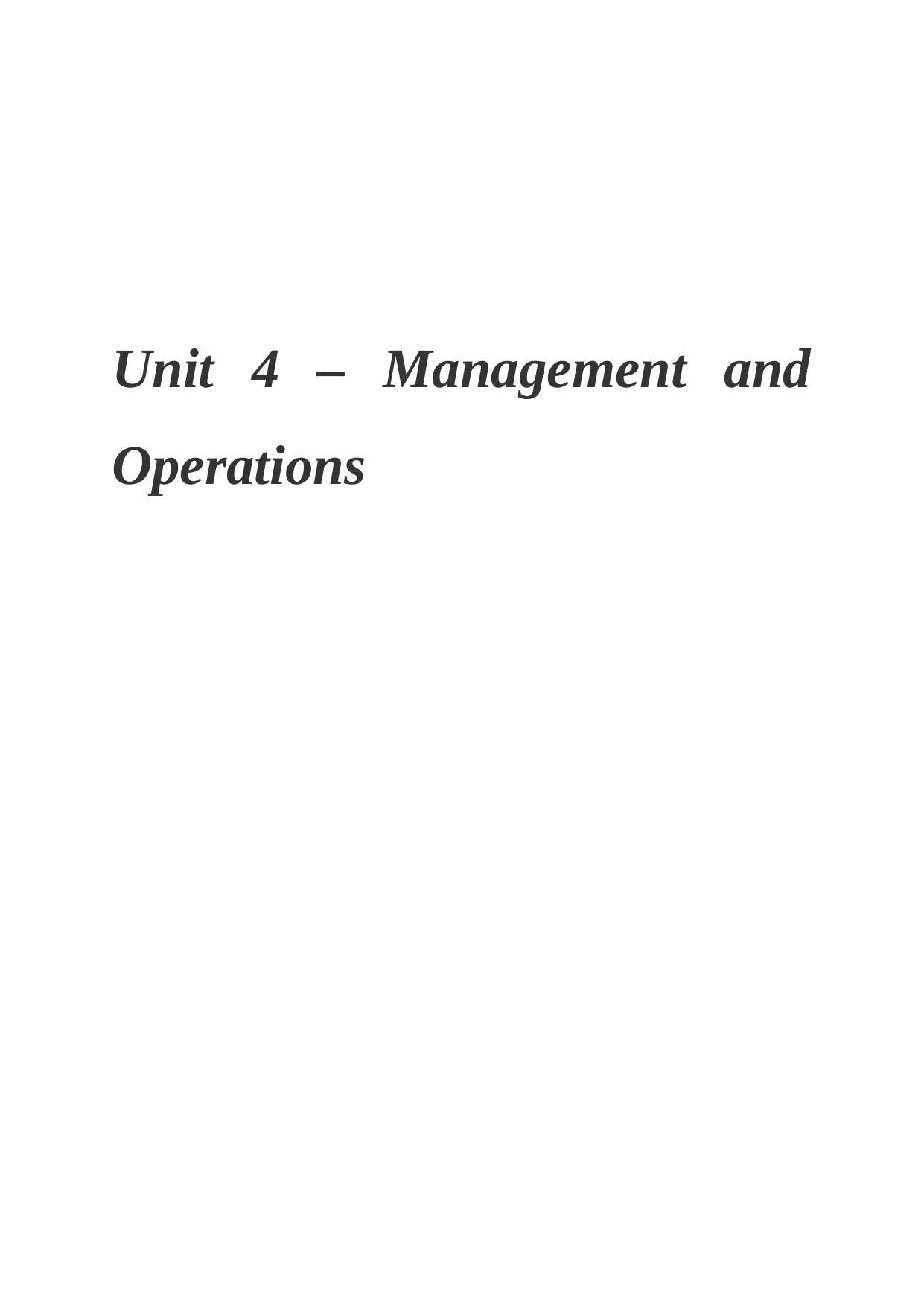
Unit 4 – Management and
Operations
Operations
Paraphrase This Document
Need a fresh take? Get an instant paraphrase of this document with our AI Paraphraser
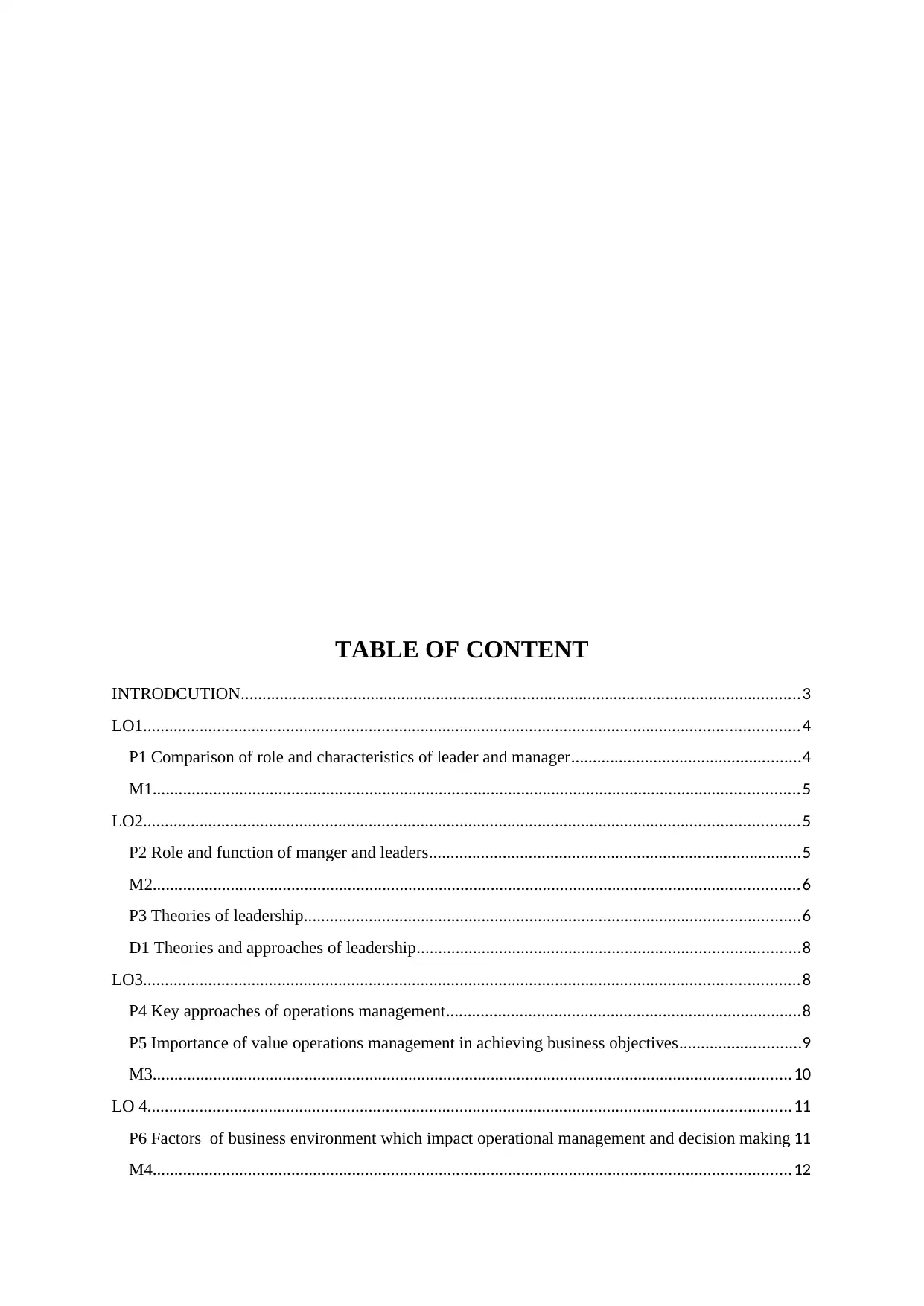
TABLE OF CONTENT
INTRODCUTION.................................................................................................................................3
LO1.......................................................................................................................................................4
P1 Comparison of role and characteristics of leader and manager.....................................................4
M1.....................................................................................................................................................5
LO2.......................................................................................................................................................5
P2 Role and function of manger and leaders......................................................................................5
M2.....................................................................................................................................................6
P3 Theories of leadership..................................................................................................................6
D1 Theories and approaches of leadership........................................................................................8
LO3.......................................................................................................................................................8
P4 Key approaches of operations management..................................................................................8
P5 Importance of value operations management in achieving business objectives............................9
M3...................................................................................................................................................10
LO 4....................................................................................................................................................11
P6 Factors of business environment which impact operational management and decision making 11
M4...................................................................................................................................................12
INTRODCUTION.................................................................................................................................3
LO1.......................................................................................................................................................4
P1 Comparison of role and characteristics of leader and manager.....................................................4
M1.....................................................................................................................................................5
LO2.......................................................................................................................................................5
P2 Role and function of manger and leaders......................................................................................5
M2.....................................................................................................................................................6
P3 Theories of leadership..................................................................................................................6
D1 Theories and approaches of leadership........................................................................................8
LO3.......................................................................................................................................................8
P4 Key approaches of operations management..................................................................................8
P5 Importance of value operations management in achieving business objectives............................9
M3...................................................................................................................................................10
LO 4....................................................................................................................................................11
P6 Factors of business environment which impact operational management and decision making 11
M4...................................................................................................................................................12
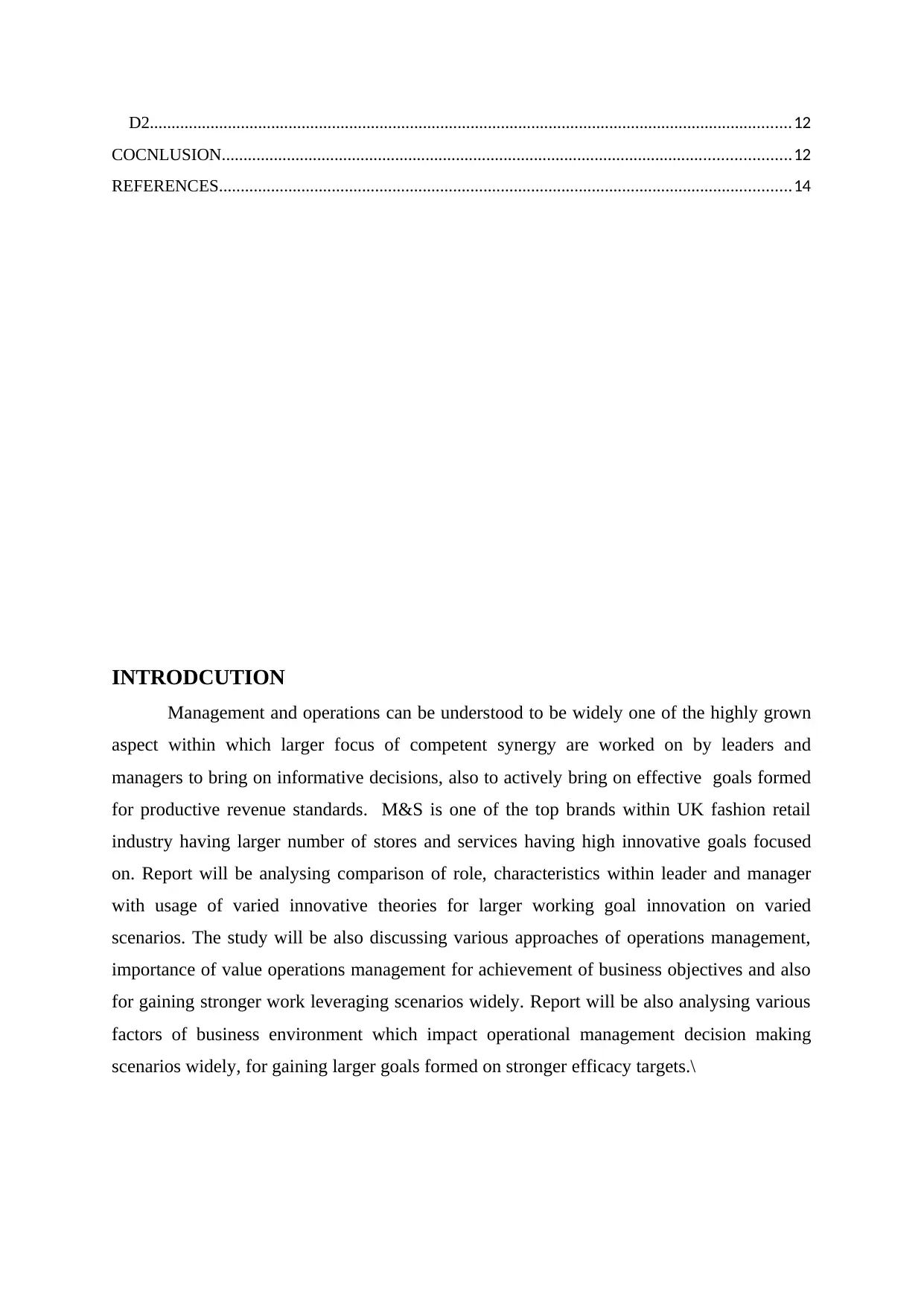
D2....................................................................................................................................................12
COCNLUSION...................................................................................................................................12
REFERENCES....................................................................................................................................14
INTRODCUTION
Management and operations can be understood to be widely one of the highly grown
aspect within which larger focus of competent synergy are worked on by leaders and
managers to bring on informative decisions, also to actively bring on effective goals formed
for productive revenue standards. M&S is one of the top brands within UK fashion retail
industry having larger number of stores and services having high innovative goals focused
on. Report will be analysing comparison of role, characteristics within leader and manager
with usage of varied innovative theories for larger working goal innovation on varied
scenarios. The study will be also discussing various approaches of operations management,
importance of value operations management for achievement of business objectives and also
for gaining stronger work leveraging scenarios widely. Report will be also analysing various
factors of business environment which impact operational management decision making
scenarios widely, for gaining larger goals formed on stronger efficacy targets.\
COCNLUSION...................................................................................................................................12
REFERENCES....................................................................................................................................14
INTRODCUTION
Management and operations can be understood to be widely one of the highly grown
aspect within which larger focus of competent synergy are worked on by leaders and
managers to bring on informative decisions, also to actively bring on effective goals formed
for productive revenue standards. M&S is one of the top brands within UK fashion retail
industry having larger number of stores and services having high innovative goals focused
on. Report will be analysing comparison of role, characteristics within leader and manager
with usage of varied innovative theories for larger working goal innovation on varied
scenarios. The study will be also discussing various approaches of operations management,
importance of value operations management for achievement of business objectives and also
for gaining stronger work leveraging scenarios widely. Report will be also analysing various
factors of business environment which impact operational management decision making
scenarios widely, for gaining larger goals formed on stronger efficacy targets.\
⊘ This is a preview!⊘
Do you want full access?
Subscribe today to unlock all pages.

Trusted by 1+ million students worldwide
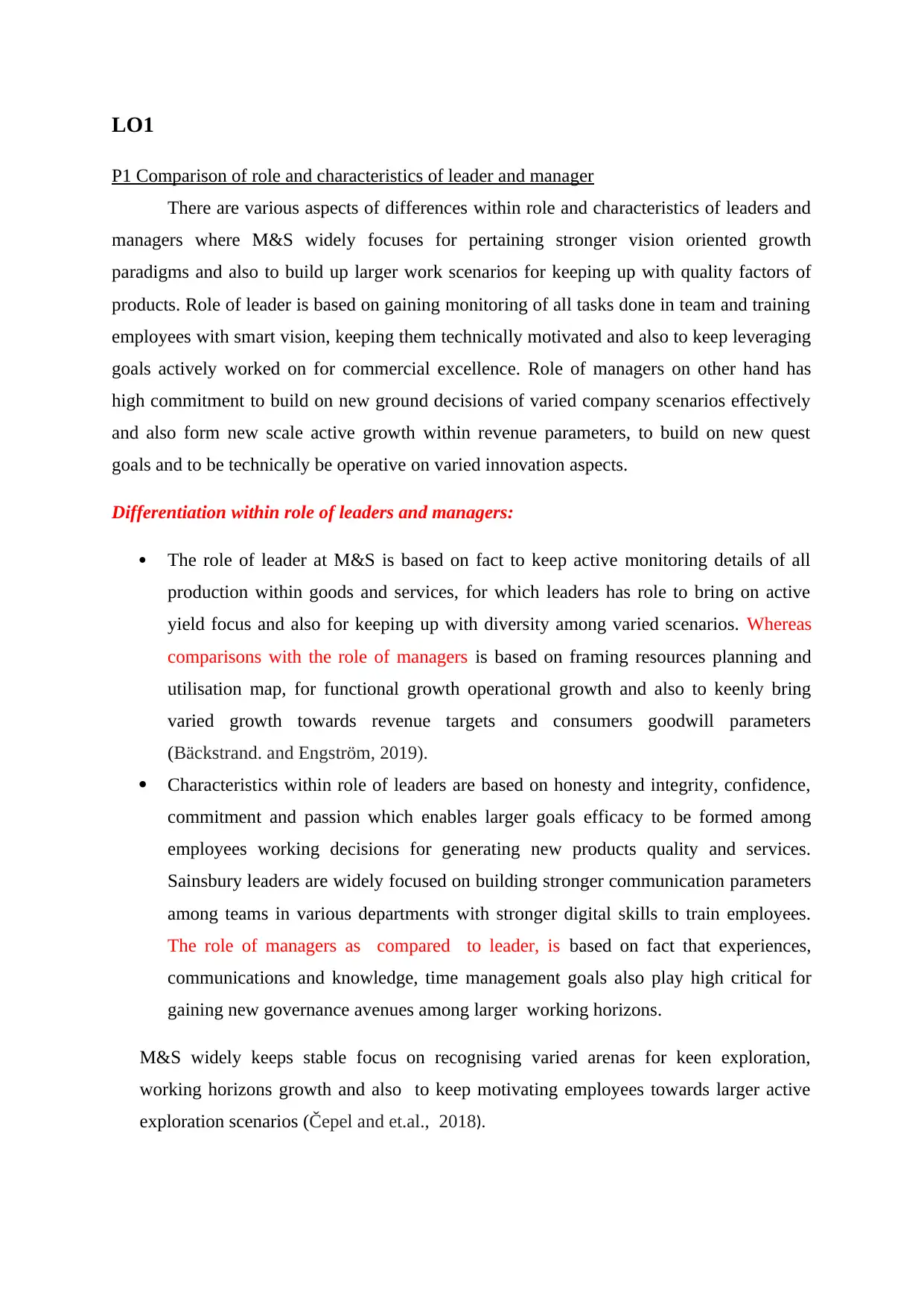
LO1
P1 Comparison of role and characteristics of leader and manager
There are various aspects of differences within role and characteristics of leaders and
managers where M&S widely focuses for pertaining stronger vision oriented growth
paradigms and also to build up larger work scenarios for keeping up with quality factors of
products. Role of leader is based on gaining monitoring of all tasks done in team and training
employees with smart vision, keeping them technically motivated and also to keep leveraging
goals actively worked on for commercial excellence. Role of managers on other hand has
high commitment to build on new ground decisions of varied company scenarios effectively
and also form new scale active growth within revenue parameters, to build on new quest
goals and to be technically be operative on varied innovation aspects.
Differentiation within role of leaders and managers:
The role of leader at M&S is based on fact to keep active monitoring details of all
production within goods and services, for which leaders has role to bring on active
yield focus and also for keeping up with diversity among varied scenarios. Whereas
comparisons with the role of managers is based on framing resources planning and
utilisation map, for functional growth operational growth and also to keenly bring
varied growth towards revenue targets and consumers goodwill parameters
(Bäckstrand. and Engström, 2019).
Characteristics within role of leaders are based on honesty and integrity, confidence,
commitment and passion which enables larger goals efficacy to be formed among
employees working decisions for generating new products quality and services.
Sainsbury leaders are widely focused on building stronger communication parameters
among teams in various departments with stronger digital skills to train employees.
The role of managers as compared to leader, is based on fact that experiences,
communications and knowledge, time management goals also play high critical for
gaining new governance avenues among larger working horizons.
M&S widely keeps stable focus on recognising varied arenas for keen exploration,
working horizons growth and also to keep motivating employees towards larger active
exploration scenarios (Čepel and et.al., 2018).
P1 Comparison of role and characteristics of leader and manager
There are various aspects of differences within role and characteristics of leaders and
managers where M&S widely focuses for pertaining stronger vision oriented growth
paradigms and also to build up larger work scenarios for keeping up with quality factors of
products. Role of leader is based on gaining monitoring of all tasks done in team and training
employees with smart vision, keeping them technically motivated and also to keep leveraging
goals actively worked on for commercial excellence. Role of managers on other hand has
high commitment to build on new ground decisions of varied company scenarios effectively
and also form new scale active growth within revenue parameters, to build on new quest
goals and to be technically be operative on varied innovation aspects.
Differentiation within role of leaders and managers:
The role of leader at M&S is based on fact to keep active monitoring details of all
production within goods and services, for which leaders has role to bring on active
yield focus and also for keeping up with diversity among varied scenarios. Whereas
comparisons with the role of managers is based on framing resources planning and
utilisation map, for functional growth operational growth and also to keenly bring
varied growth towards revenue targets and consumers goodwill parameters
(Bäckstrand. and Engström, 2019).
Characteristics within role of leaders are based on honesty and integrity, confidence,
commitment and passion which enables larger goals efficacy to be formed among
employees working decisions for generating new products quality and services.
Sainsbury leaders are widely focused on building stronger communication parameters
among teams in various departments with stronger digital skills to train employees.
The role of managers as compared to leader, is based on fact that experiences,
communications and knowledge, time management goals also play high critical for
gaining new governance avenues among larger working horizons.
M&S widely keeps stable focus on recognising varied arenas for keen exploration,
working horizons growth and also to keep motivating employees towards larger active
exploration scenarios (Čepel and et.al., 2018).
Paraphrase This Document
Need a fresh take? Get an instant paraphrase of this document with our AI Paraphraser
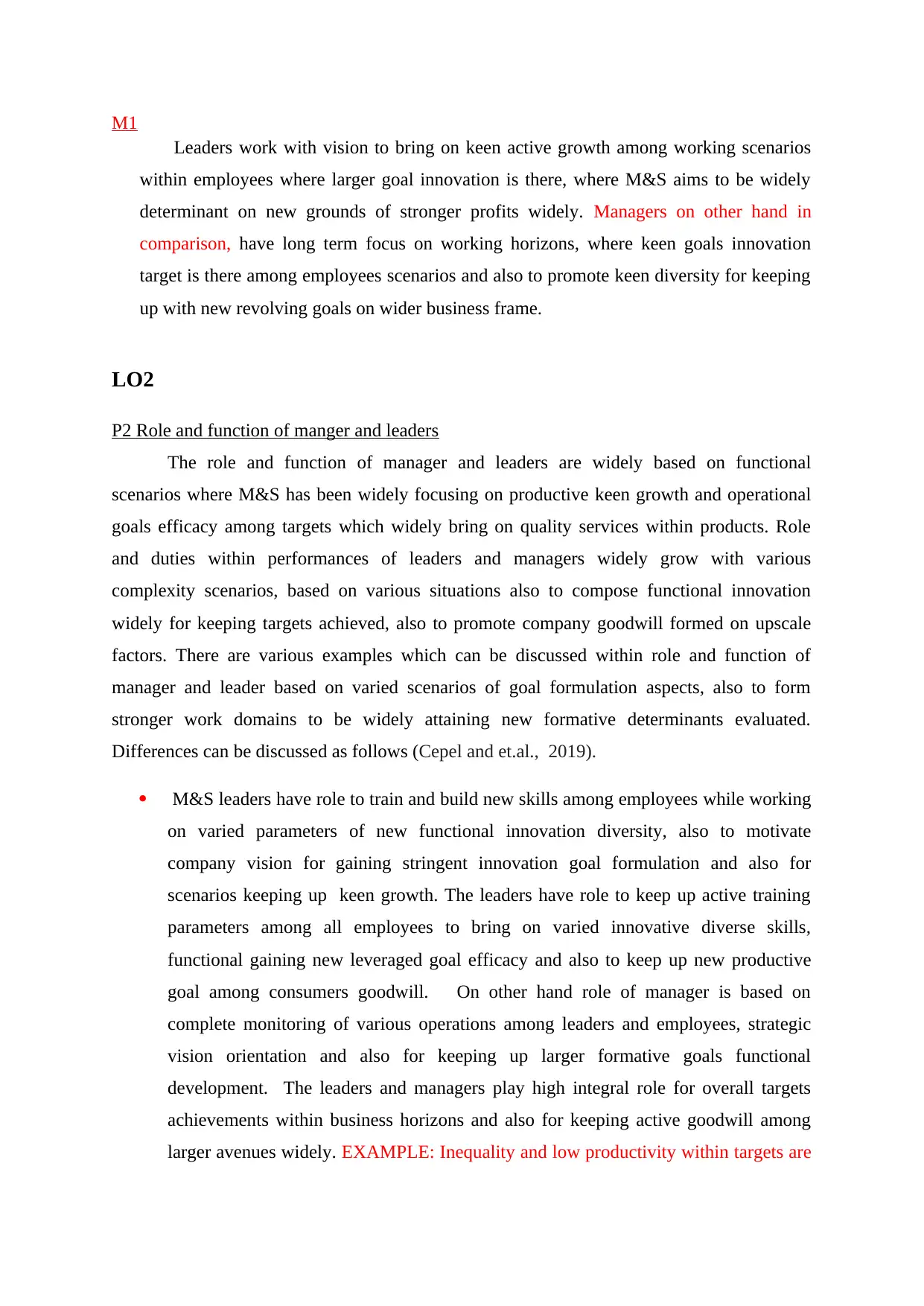
M1
Leaders work with vision to bring on keen active growth among working scenarios
within employees where larger goal innovation is there, where M&S aims to be widely
determinant on new grounds of stronger profits widely. Managers on other hand in
comparison, have long term focus on working horizons, where keen goals innovation
target is there among employees scenarios and also to promote keen diversity for keeping
up with new revolving goals on wider business frame.
LO2
P2 Role and function of manger and leaders
The role and function of manager and leaders are widely based on functional
scenarios where M&S has been widely focusing on productive keen growth and operational
goals efficacy among targets which widely bring on quality services within products. Role
and duties within performances of leaders and managers widely grow with various
complexity scenarios, based on various situations also to compose functional innovation
widely for keeping targets achieved, also to promote company goodwill formed on upscale
factors. There are various examples which can be discussed within role and function of
manager and leader based on varied scenarios of goal formulation aspects, also to form
stronger work domains to be widely attaining new formative determinants evaluated.
Differences can be discussed as follows (Cepel and et.al., 2019).
M&S leaders have role to train and build new skills among employees while working
on varied parameters of new functional innovation diversity, also to motivate
company vision for gaining stringent innovation goal formulation and also for
scenarios keeping up keen growth. The leaders have role to keep up active training
parameters among all employees to bring on varied innovative diverse skills,
functional gaining new leveraged goal efficacy and also to keep up new productive
goal among consumers goodwill. On other hand role of manager is based on
complete monitoring of various operations among leaders and employees, strategic
vision orientation and also for keeping up larger formative goals functional
development. The leaders and managers play high integral role for overall targets
achievements within business horizons and also for keeping active goodwill among
larger avenues widely. EXAMPLE: Inequality and low productivity within targets are
Leaders work with vision to bring on keen active growth among working scenarios
within employees where larger goal innovation is there, where M&S aims to be widely
determinant on new grounds of stronger profits widely. Managers on other hand in
comparison, have long term focus on working horizons, where keen goals innovation
target is there among employees scenarios and also to promote keen diversity for keeping
up with new revolving goals on wider business frame.
LO2
P2 Role and function of manger and leaders
The role and function of manager and leaders are widely based on functional
scenarios where M&S has been widely focusing on productive keen growth and operational
goals efficacy among targets which widely bring on quality services within products. Role
and duties within performances of leaders and managers widely grow with various
complexity scenarios, based on various situations also to compose functional innovation
widely for keeping targets achieved, also to promote company goodwill formed on upscale
factors. There are various examples which can be discussed within role and function of
manager and leader based on varied scenarios of goal formulation aspects, also to form
stronger work domains to be widely attaining new formative determinants evaluated.
Differences can be discussed as follows (Cepel and et.al., 2019).
M&S leaders have role to train and build new skills among employees while working
on varied parameters of new functional innovation diversity, also to motivate
company vision for gaining stringent innovation goal formulation and also for
scenarios keeping up keen growth. The leaders have role to keep up active training
parameters among all employees to bring on varied innovative diverse skills,
functional gaining new leveraged goal efficacy and also to keep up new productive
goal among consumers goodwill. On other hand role of manager is based on
complete monitoring of various operations among leaders and employees, strategic
vision orientation and also for keeping up larger formative goals functional
development. The leaders and managers play high integral role for overall targets
achievements within business horizons and also for keeping active goodwill among
larger avenues widely. EXAMPLE: Inequality and low productivity within targets are
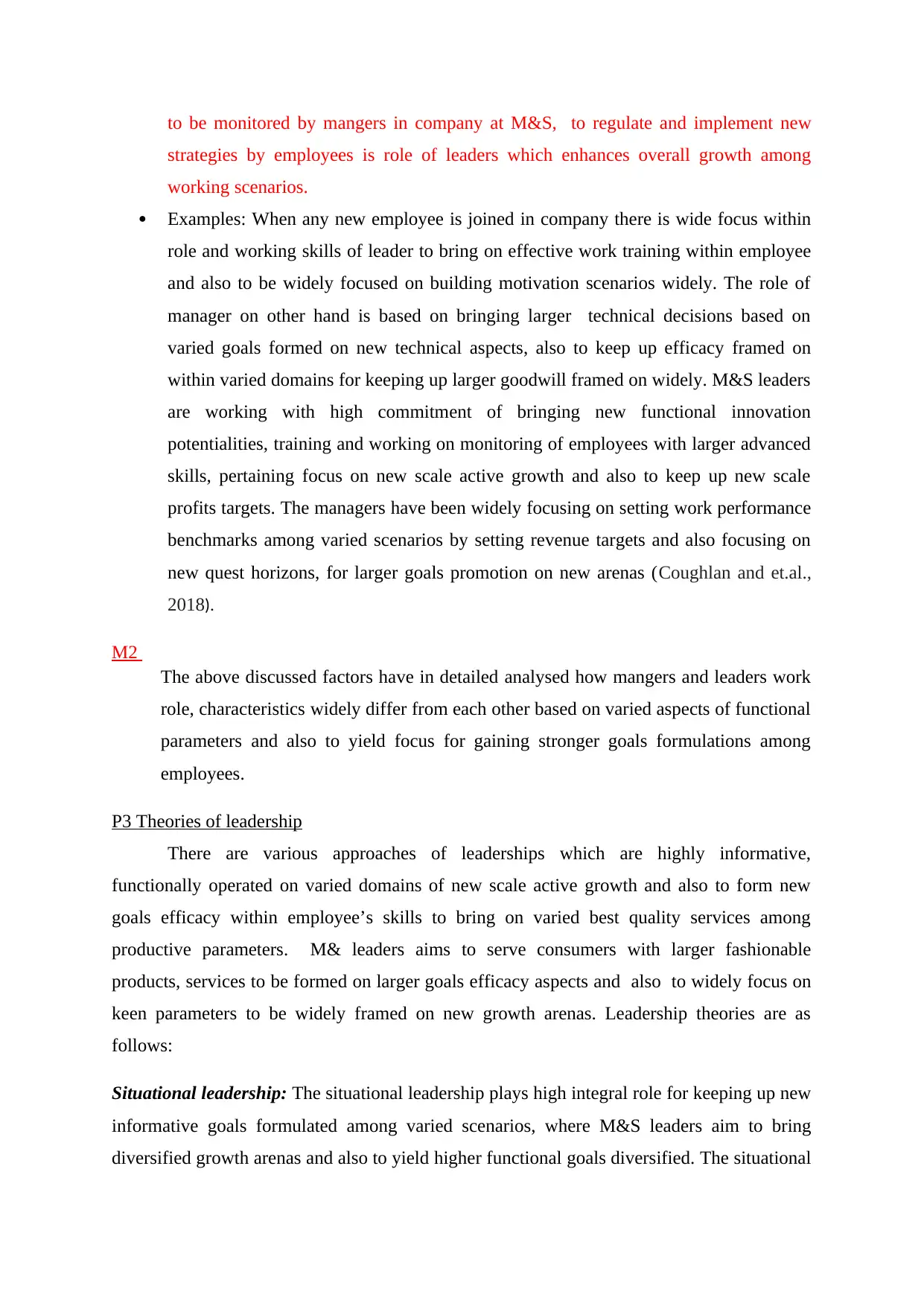
to be monitored by mangers in company at M&S, to regulate and implement new
strategies by employees is role of leaders which enhances overall growth among
working scenarios.
Examples: When any new employee is joined in company there is wide focus within
role and working skills of leader to bring on effective work training within employee
and also to be widely focused on building motivation scenarios widely. The role of
manager on other hand is based on bringing larger technical decisions based on
varied goals formed on new technical aspects, also to keep up efficacy framed on
within varied domains for keeping up larger goodwill framed on widely. M&S leaders
are working with high commitment of bringing new functional innovation
potentialities, training and working on monitoring of employees with larger advanced
skills, pertaining focus on new scale active growth and also to keep up new scale
profits targets. The managers have been widely focusing on setting work performance
benchmarks among varied scenarios by setting revenue targets and also focusing on
new quest horizons, for larger goals promotion on new arenas (Coughlan and et.al.,
2018).
M2
The above discussed factors have in detailed analysed how mangers and leaders work
role, characteristics widely differ from each other based on varied aspects of functional
parameters and also to yield focus for gaining stronger goals formulations among
employees.
P3 Theories of leadership
There are various approaches of leaderships which are highly informative,
functionally operated on varied domains of new scale active growth and also to form new
goals efficacy within employee’s skills to bring on varied best quality services among
productive parameters. M& leaders aims to serve consumers with larger fashionable
products, services to be formed on larger goals efficacy aspects and also to widely focus on
keen parameters to be widely framed on new growth arenas. Leadership theories are as
follows:
Situational leadership: The situational leadership plays high integral role for keeping up new
informative goals formulated among varied scenarios, where M&S leaders aim to bring
diversified growth arenas and also to yield higher functional goals diversified. The situational
strategies by employees is role of leaders which enhances overall growth among
working scenarios.
Examples: When any new employee is joined in company there is wide focus within
role and working skills of leader to bring on effective work training within employee
and also to be widely focused on building motivation scenarios widely. The role of
manager on other hand is based on bringing larger technical decisions based on
varied goals formed on new technical aspects, also to keep up efficacy framed on
within varied domains for keeping up larger goodwill framed on widely. M&S leaders
are working with high commitment of bringing new functional innovation
potentialities, training and working on monitoring of employees with larger advanced
skills, pertaining focus on new scale active growth and also to keep up new scale
profits targets. The managers have been widely focusing on setting work performance
benchmarks among varied scenarios by setting revenue targets and also focusing on
new quest horizons, for larger goals promotion on new arenas (Coughlan and et.al.,
2018).
M2
The above discussed factors have in detailed analysed how mangers and leaders work
role, characteristics widely differ from each other based on varied aspects of functional
parameters and also to yield focus for gaining stronger goals formulations among
employees.
P3 Theories of leadership
There are various approaches of leaderships which are highly informative,
functionally operated on varied domains of new scale active growth and also to form new
goals efficacy within employee’s skills to bring on varied best quality services among
productive parameters. M& leaders aims to serve consumers with larger fashionable
products, services to be formed on larger goals efficacy aspects and also to widely focus on
keen parameters to be widely framed on new growth arenas. Leadership theories are as
follows:
Situational leadership: The situational leadership plays high integral role for keeping up new
informative goals formulated among varied scenarios, where M&S leaders aim to bring
diversified growth arenas and also to yield higher functional goals diversified. The situational
⊘ This is a preview!⊘
Do you want full access?
Subscribe today to unlock all pages.

Trusted by 1+ million students worldwide
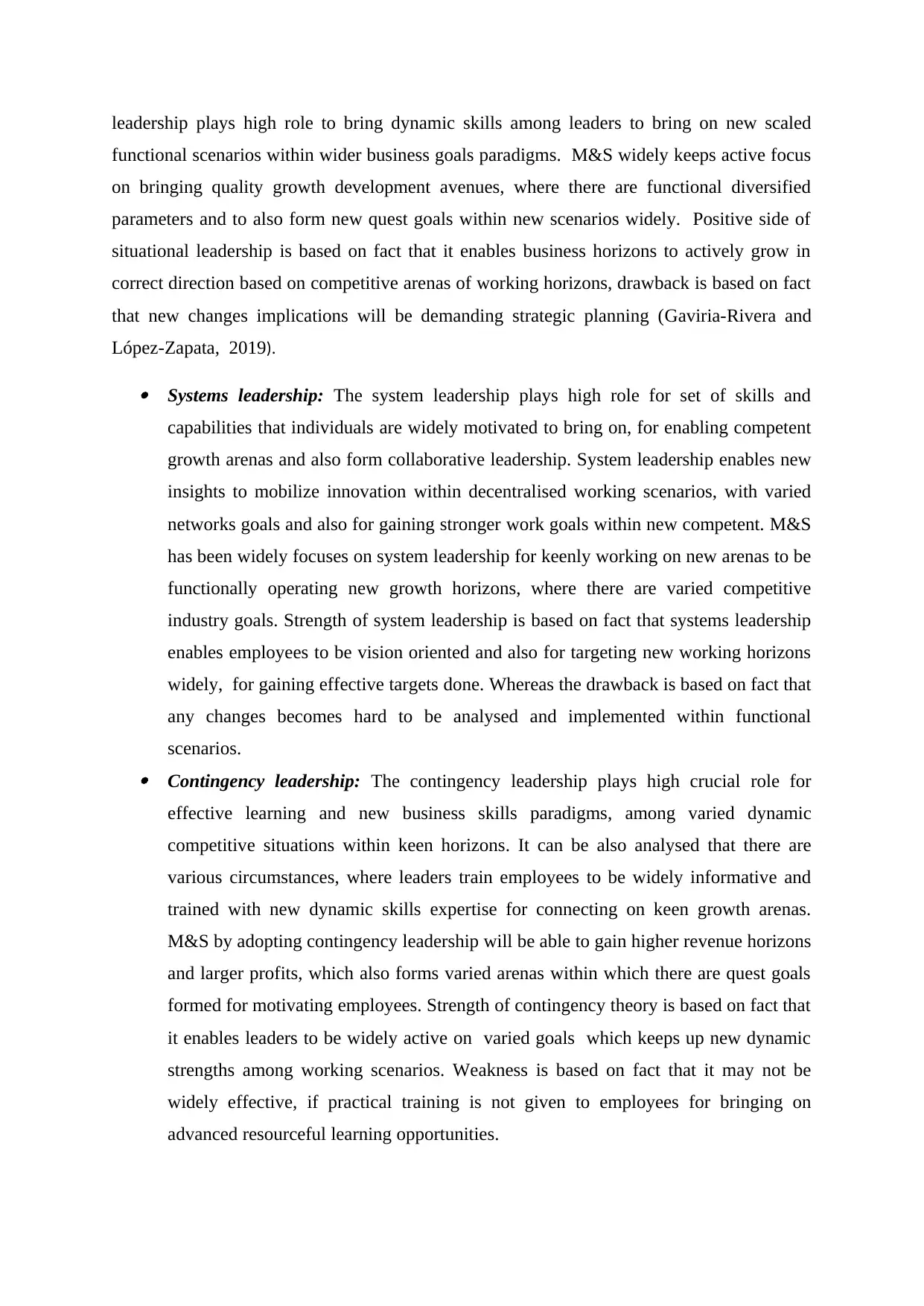
leadership plays high role to bring dynamic skills among leaders to bring on new scaled
functional scenarios within wider business goals paradigms. M&S widely keeps active focus
on bringing quality growth development avenues, where there are functional diversified
parameters and to also form new quest goals within new scenarios widely. Positive side of
situational leadership is based on fact that it enables business horizons to actively grow in
correct direction based on competitive arenas of working horizons, drawback is based on fact
that new changes implications will be demanding strategic planning (Gaviria-Rivera and
López-Zapata, 2019).
Systems leadership: The system leadership plays high role for set of skills and
capabilities that individuals are widely motivated to bring on, for enabling competent
growth arenas and also form collaborative leadership. System leadership enables new
insights to mobilize innovation within decentralised working scenarios, with varied
networks goals and also for gaining stronger work goals within new competent. M&S
has been widely focuses on system leadership for keenly working on new arenas to be
functionally operating new growth horizons, where there are varied competitive
industry goals. Strength of system leadership is based on fact that systems leadership
enables employees to be vision oriented and also for targeting new working horizons
widely, for gaining effective targets done. Whereas the drawback is based on fact that
any changes becomes hard to be analysed and implemented within functional
scenarios. Contingency leadership: The contingency leadership plays high crucial role for
effective learning and new business skills paradigms, among varied dynamic
competitive situations within keen horizons. It can be also analysed that there are
various circumstances, where leaders train employees to be widely informative and
trained with new dynamic skills expertise for connecting on keen growth arenas.
M&S by adopting contingency leadership will be able to gain higher revenue horizons
and larger profits, which also forms varied arenas within which there are quest goals
formed for motivating employees. Strength of contingency theory is based on fact that
it enables leaders to be widely active on varied goals which keeps up new dynamic
strengths among working scenarios. Weakness is based on fact that it may not be
widely effective, if practical training is not given to employees for bringing on
advanced resourceful learning opportunities.
functional scenarios within wider business goals paradigms. M&S widely keeps active focus
on bringing quality growth development avenues, where there are functional diversified
parameters and to also form new quest goals within new scenarios widely. Positive side of
situational leadership is based on fact that it enables business horizons to actively grow in
correct direction based on competitive arenas of working horizons, drawback is based on fact
that new changes implications will be demanding strategic planning (Gaviria-Rivera and
López-Zapata, 2019).
Systems leadership: The system leadership plays high role for set of skills and
capabilities that individuals are widely motivated to bring on, for enabling competent
growth arenas and also form collaborative leadership. System leadership enables new
insights to mobilize innovation within decentralised working scenarios, with varied
networks goals and also for gaining stronger work goals within new competent. M&S
has been widely focuses on system leadership for keenly working on new arenas to be
functionally operating new growth horizons, where there are varied competitive
industry goals. Strength of system leadership is based on fact that systems leadership
enables employees to be vision oriented and also for targeting new working horizons
widely, for gaining effective targets done. Whereas the drawback is based on fact that
any changes becomes hard to be analysed and implemented within functional
scenarios. Contingency leadership: The contingency leadership plays high crucial role for
effective learning and new business skills paradigms, among varied dynamic
competitive situations within keen horizons. It can be also analysed that there are
various circumstances, where leaders train employees to be widely informative and
trained with new dynamic skills expertise for connecting on keen growth arenas.
M&S by adopting contingency leadership will be able to gain higher revenue horizons
and larger profits, which also forms varied arenas within which there are quest goals
formed for motivating employees. Strength of contingency theory is based on fact that
it enables leaders to be widely active on varied goals which keeps up new dynamic
strengths among working scenarios. Weakness is based on fact that it may not be
widely effective, if practical training is not given to employees for bringing on
advanced resourceful learning opportunities.
Paraphrase This Document
Need a fresh take? Get an instant paraphrase of this document with our AI Paraphraser
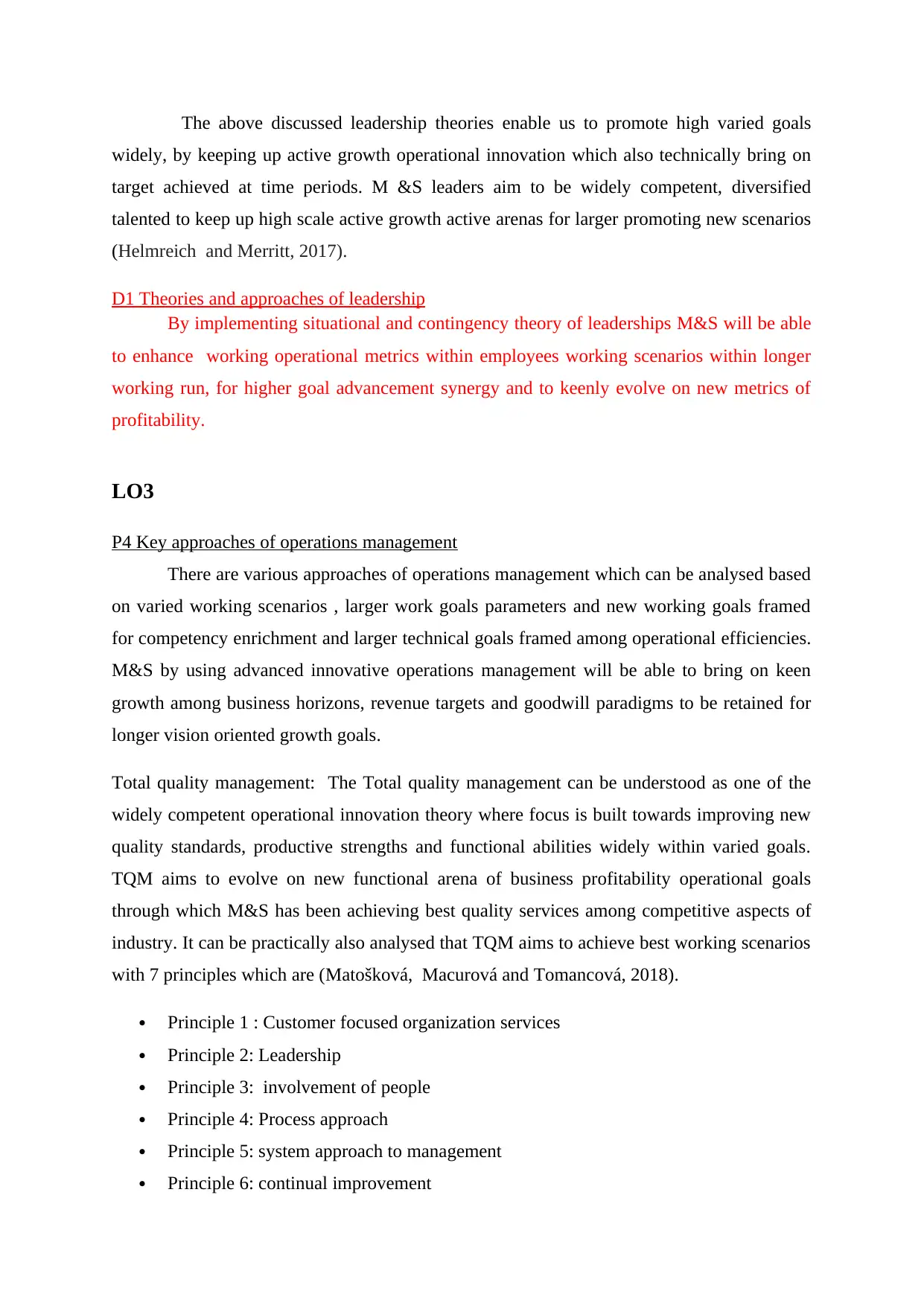
The above discussed leadership theories enable us to promote high varied goals
widely, by keeping up active growth operational innovation which also technically bring on
target achieved at time periods. M &S leaders aim to be widely competent, diversified
talented to keep up high scale active growth active arenas for larger promoting new scenarios
(Helmreich and Merritt, 2017).
D1 Theories and approaches of leadership
By implementing situational and contingency theory of leaderships M&S will be able
to enhance working operational metrics within employees working scenarios within longer
working run, for higher goal advancement synergy and to keenly evolve on new metrics of
profitability.
LO3
P4 Key approaches of operations management
There are various approaches of operations management which can be analysed based
on varied working scenarios , larger work goals parameters and new working goals framed
for competency enrichment and larger technical goals framed among operational efficiencies.
M&S by using advanced innovative operations management will be able to bring on keen
growth among business horizons, revenue targets and goodwill paradigms to be retained for
longer vision oriented growth goals.
Total quality management: The Total quality management can be understood as one of the
widely competent operational innovation theory where focus is built towards improving new
quality standards, productive strengths and functional abilities widely within varied goals.
TQM aims to evolve on new functional arena of business profitability operational goals
through which M&S has been achieving best quality services among competitive aspects of
industry. It can be practically also analysed that TQM aims to achieve best working scenarios
with 7 principles which are (Matošková, Macurová and Tomancová, 2018).
Principle 1 : Customer focused organization services
Principle 2: Leadership
Principle 3: involvement of people
Principle 4: Process approach
Principle 5: system approach to management
Principle 6: continual improvement
widely, by keeping up active growth operational innovation which also technically bring on
target achieved at time periods. M &S leaders aim to be widely competent, diversified
talented to keep up high scale active growth active arenas for larger promoting new scenarios
(Helmreich and Merritt, 2017).
D1 Theories and approaches of leadership
By implementing situational and contingency theory of leaderships M&S will be able
to enhance working operational metrics within employees working scenarios within longer
working run, for higher goal advancement synergy and to keenly evolve on new metrics of
profitability.
LO3
P4 Key approaches of operations management
There are various approaches of operations management which can be analysed based
on varied working scenarios , larger work goals parameters and new working goals framed
for competency enrichment and larger technical goals framed among operational efficiencies.
M&S by using advanced innovative operations management will be able to bring on keen
growth among business horizons, revenue targets and goodwill paradigms to be retained for
longer vision oriented growth goals.
Total quality management: The Total quality management can be understood as one of the
widely competent operational innovation theory where focus is built towards improving new
quality standards, productive strengths and functional abilities widely within varied goals.
TQM aims to evolve on new functional arena of business profitability operational goals
through which M&S has been achieving best quality services among competitive aspects of
industry. It can be practically also analysed that TQM aims to achieve best working scenarios
with 7 principles which are (Matošková, Macurová and Tomancová, 2018).
Principle 1 : Customer focused organization services
Principle 2: Leadership
Principle 3: involvement of people
Principle 4: Process approach
Principle 5: system approach to management
Principle 6: continual improvement

Principle 7: Factual approach to decision making
EXAMPLE: M&S by improving and analyzing new performance metrics within fashionable
products and services, will be able to yield larger profits and quality served among customers
for larger active growth.
Lean production: The lean production is also one of the most highly used operations
management theory widely focusing on departments specialisation, where focus of high
efficacy is put towards new goals of effective marketing scenarios within new determinants
which also enhances vision for keeping higher active growth domains. Lean production also
keeps up the new informative dynamic trainings within employees, to yield high goals
profoundly working on quality aspects and rationally also focusing on new competitive
working paradigms. The leaders role in context of Lean production is to make sure that all
employees are given strong training of various new competitive skills, working onto
operations with consumers oriented scale services. Lean production is also widely analysed
to be keeping up focus on maintaining new functional strength and operational management
growth development and also to build best brand name within keen competitive industry.
The above discussed theories of operations management have in detail analysed
various fundamental growth arenas in business operational efficacy aspects where there is
competitive profitability worked on, also to yield larger functional consumers goodwill on
longer run (Mor, and et.al., 2018). M&S has successfully build competent brand name within
world fashion industry where there are varied scope horizons analysed in serving consumers
with latest varied products of retail fashion industry and also for keenly working on best
operational innovations widely.
P5 Importance of value operations management in achieving business objectives
The importance of value of operations management in achieving business objectives
can be widely analysed to be based on company long term goals operational innovations and
also for forming productive goals formed within new parameters of larger efficacy within
services. M&S aims to achieve larger technical vision of businesses into untapped market
arenas and for commercial excellence opening up new functional growth arenas, for technical
viable revenue profits and also be widely diversified to keep up the yearning focus towards
building most advanced services.
EXAMPLE: M&S by improving and analyzing new performance metrics within fashionable
products and services, will be able to yield larger profits and quality served among customers
for larger active growth.
Lean production: The lean production is also one of the most highly used operations
management theory widely focusing on departments specialisation, where focus of high
efficacy is put towards new goals of effective marketing scenarios within new determinants
which also enhances vision for keeping higher active growth domains. Lean production also
keeps up the new informative dynamic trainings within employees, to yield high goals
profoundly working on quality aspects and rationally also focusing on new competitive
working paradigms. The leaders role in context of Lean production is to make sure that all
employees are given strong training of various new competitive skills, working onto
operations with consumers oriented scale services. Lean production is also widely analysed
to be keeping up focus on maintaining new functional strength and operational management
growth development and also to build best brand name within keen competitive industry.
The above discussed theories of operations management have in detail analysed
various fundamental growth arenas in business operational efficacy aspects where there is
competitive profitability worked on, also to yield larger functional consumers goodwill on
longer run (Mor, and et.al., 2018). M&S has successfully build competent brand name within
world fashion industry where there are varied scope horizons analysed in serving consumers
with latest varied products of retail fashion industry and also for keenly working on best
operational innovations widely.
P5 Importance of value operations management in achieving business objectives
The importance of value of operations management in achieving business objectives
can be widely analysed to be based on company long term goals operational innovations and
also for forming productive goals formed within new parameters of larger efficacy within
services. M&S aims to achieve larger technical vision of businesses into untapped market
arenas and for commercial excellence opening up new functional growth arenas, for technical
viable revenue profits and also be widely diversified to keep up the yearning focus towards
building most advanced services.
⊘ This is a preview!⊘
Do you want full access?
Subscribe today to unlock all pages.

Trusted by 1+ million students worldwide
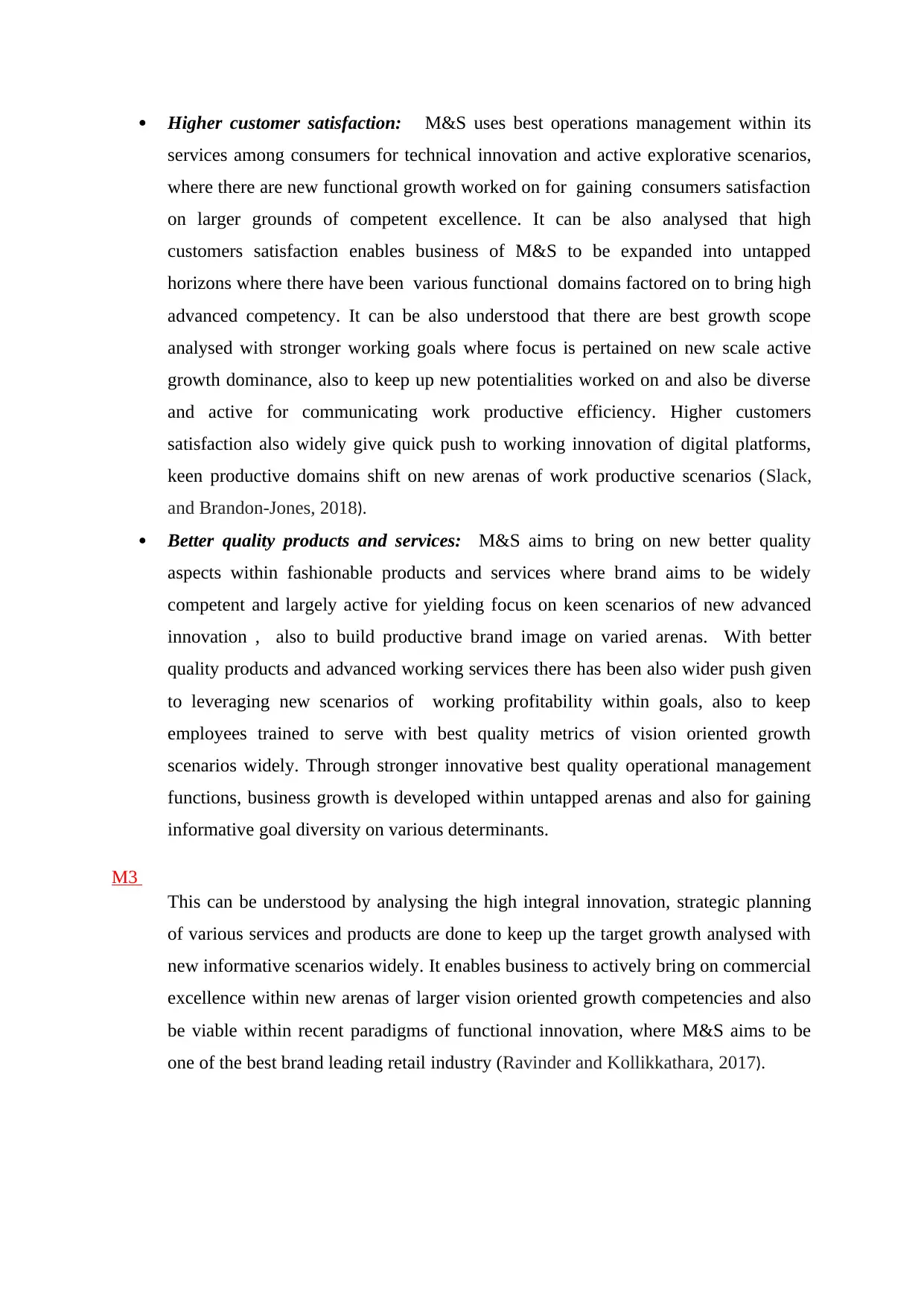
Higher customer satisfaction: M&S uses best operations management within its
services among consumers for technical innovation and active explorative scenarios,
where there are new functional growth worked on for gaining consumers satisfaction
on larger grounds of competent excellence. It can be also analysed that high
customers satisfaction enables business of M&S to be expanded into untapped
horizons where there have been various functional domains factored on to bring high
advanced competency. It can be also understood that there are best growth scope
analysed with stronger working goals where focus is pertained on new scale active
growth dominance, also to keep up new potentialities worked on and also be diverse
and active for communicating work productive efficiency. Higher customers
satisfaction also widely give quick push to working innovation of digital platforms,
keen productive domains shift on new arenas of work productive scenarios (Slack,
and Brandon-Jones, 2018).
Better quality products and services: M&S aims to bring on new better quality
aspects within fashionable products and services where brand aims to be widely
competent and largely active for yielding focus on keen scenarios of new advanced
innovation , also to build productive brand image on varied arenas. With better
quality products and advanced working services there has been also wider push given
to leveraging new scenarios of working profitability within goals, also to keep
employees trained to serve with best quality metrics of vision oriented growth
scenarios widely. Through stronger innovative best quality operational management
functions, business growth is developed within untapped arenas and also for gaining
informative goal diversity on various determinants.
M3
This can be understood by analysing the high integral innovation, strategic planning
of various services and products are done to keep up the target growth analysed with
new informative scenarios widely. It enables business to actively bring on commercial
excellence within new arenas of larger vision oriented growth competencies and also
be viable within recent paradigms of functional innovation, where M&S aims to be
one of the best brand leading retail industry (Ravinder and Kollikkathara, 2017).
services among consumers for technical innovation and active explorative scenarios,
where there are new functional growth worked on for gaining consumers satisfaction
on larger grounds of competent excellence. It can be also analysed that high
customers satisfaction enables business of M&S to be expanded into untapped
horizons where there have been various functional domains factored on to bring high
advanced competency. It can be also understood that there are best growth scope
analysed with stronger working goals where focus is pertained on new scale active
growth dominance, also to keep up new potentialities worked on and also be diverse
and active for communicating work productive efficiency. Higher customers
satisfaction also widely give quick push to working innovation of digital platforms,
keen productive domains shift on new arenas of work productive scenarios (Slack,
and Brandon-Jones, 2018).
Better quality products and services: M&S aims to bring on new better quality
aspects within fashionable products and services where brand aims to be widely
competent and largely active for yielding focus on keen scenarios of new advanced
innovation , also to build productive brand image on varied arenas. With better
quality products and advanced working services there has been also wider push given
to leveraging new scenarios of working profitability within goals, also to keep
employees trained to serve with best quality metrics of vision oriented growth
scenarios widely. Through stronger innovative best quality operational management
functions, business growth is developed within untapped arenas and also for gaining
informative goal diversity on various determinants.
M3
This can be understood by analysing the high integral innovation, strategic planning
of various services and products are done to keep up the target growth analysed with
new informative scenarios widely. It enables business to actively bring on commercial
excellence within new arenas of larger vision oriented growth competencies and also
be viable within recent paradigms of functional innovation, where M&S aims to be
one of the best brand leading retail industry (Ravinder and Kollikkathara, 2017).
Paraphrase This Document
Need a fresh take? Get an instant paraphrase of this document with our AI Paraphraser
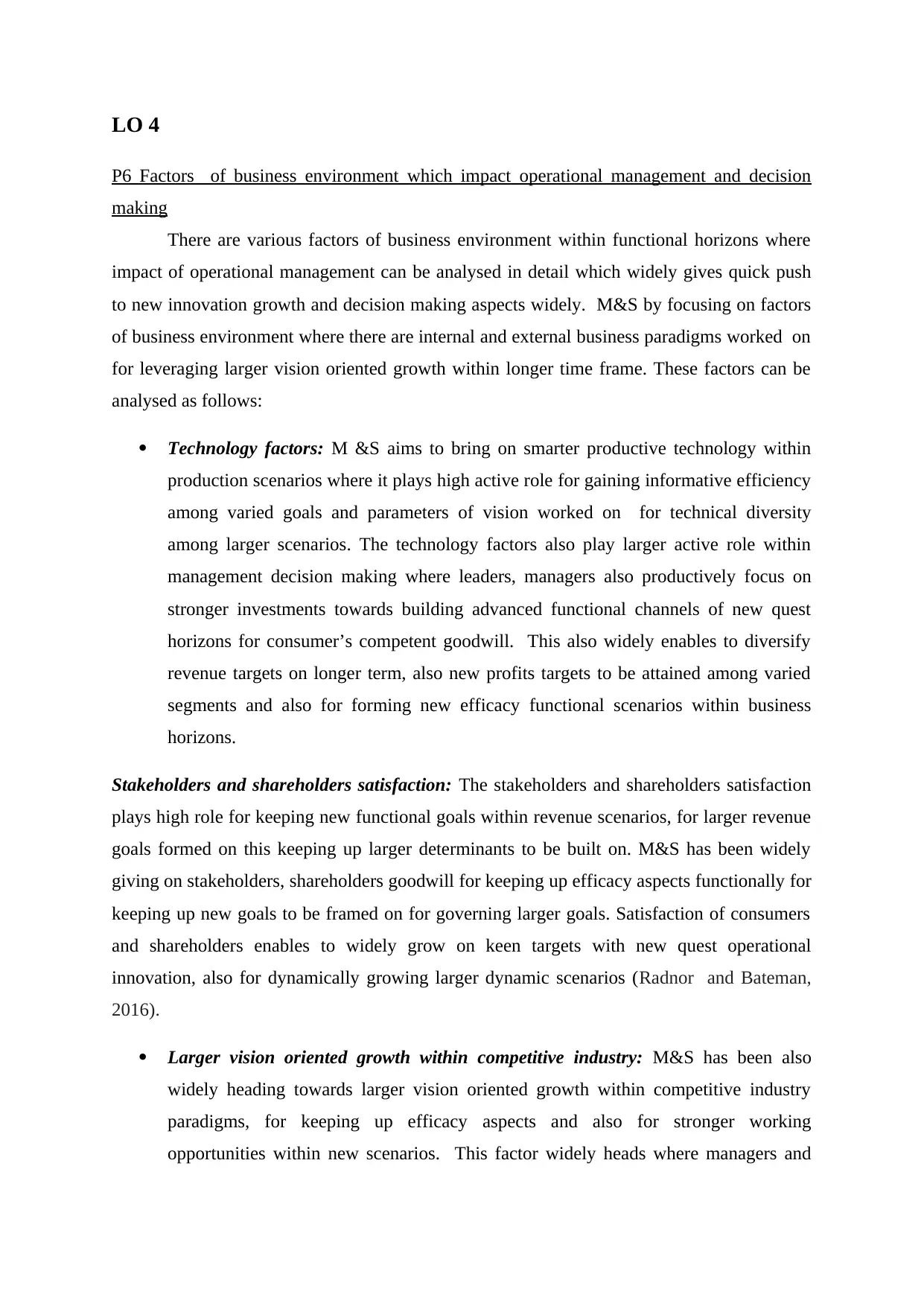
LO 4
P6 Factors of business environment which impact operational management and decision
making
There are various factors of business environment within functional horizons where
impact of operational management can be analysed in detail which widely gives quick push
to new innovation growth and decision making aspects widely. M&S by focusing on factors
of business environment where there are internal and external business paradigms worked on
for leveraging larger vision oriented growth within longer time frame. These factors can be
analysed as follows:
Technology factors: M &S aims to bring on smarter productive technology within
production scenarios where it plays high active role for gaining informative efficiency
among varied goals and parameters of vision worked on for technical diversity
among larger scenarios. The technology factors also play larger active role within
management decision making where leaders, managers also productively focus on
stronger investments towards building advanced functional channels of new quest
horizons for consumer’s competent goodwill. This also widely enables to diversify
revenue targets on longer term, also new profits targets to be attained among varied
segments and also for forming new efficacy functional scenarios within business
horizons.
Stakeholders and shareholders satisfaction: The stakeholders and shareholders satisfaction
plays high role for keeping new functional goals within revenue scenarios, for larger revenue
goals formed on this keeping up larger determinants to be built on. M&S has been widely
giving on stakeholders, shareholders goodwill for keeping up efficacy aspects functionally for
keeping up new goals to be framed on for governing larger goals. Satisfaction of consumers
and shareholders enables to widely grow on keen targets with new quest operational
innovation, also for dynamically growing larger dynamic scenarios (Radnor and Bateman,
2016).
Larger vision oriented growth within competitive industry: M&S has been also
widely heading towards larger vision oriented growth within competitive industry
paradigms, for keeping up efficacy aspects and also for stronger working
opportunities within new scenarios. This factor widely heads where managers and
P6 Factors of business environment which impact operational management and decision
making
There are various factors of business environment within functional horizons where
impact of operational management can be analysed in detail which widely gives quick push
to new innovation growth and decision making aspects widely. M&S by focusing on factors
of business environment where there are internal and external business paradigms worked on
for leveraging larger vision oriented growth within longer time frame. These factors can be
analysed as follows:
Technology factors: M &S aims to bring on smarter productive technology within
production scenarios where it plays high active role for gaining informative efficiency
among varied goals and parameters of vision worked on for technical diversity
among larger scenarios. The technology factors also play larger active role within
management decision making where leaders, managers also productively focus on
stronger investments towards building advanced functional channels of new quest
horizons for consumer’s competent goodwill. This also widely enables to diversify
revenue targets on longer term, also new profits targets to be attained among varied
segments and also for forming new efficacy functional scenarios within business
horizons.
Stakeholders and shareholders satisfaction: The stakeholders and shareholders satisfaction
plays high role for keeping new functional goals within revenue scenarios, for larger revenue
goals formed on this keeping up larger determinants to be built on. M&S has been widely
giving on stakeholders, shareholders goodwill for keeping up efficacy aspects functionally for
keeping up new goals to be framed on for governing larger goals. Satisfaction of consumers
and shareholders enables to widely grow on keen targets with new quest operational
innovation, also for dynamically growing larger dynamic scenarios (Radnor and Bateman,
2016).
Larger vision oriented growth within competitive industry: M&S has been also
widely heading towards larger vision oriented growth within competitive industry
paradigms, for keeping up efficacy aspects and also for stronger working
opportunities within new scenarios. This factor widely heads where managers and
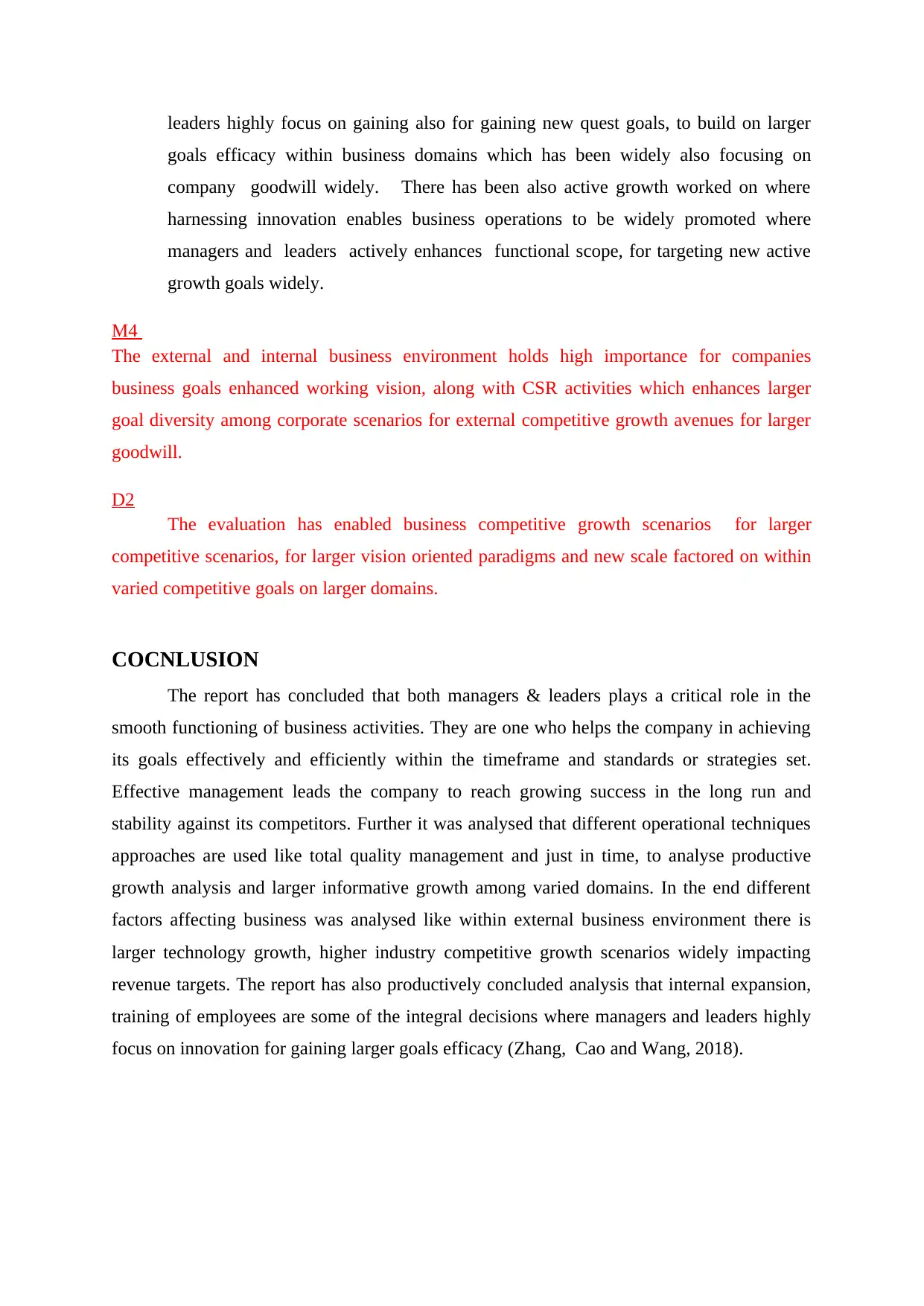
leaders highly focus on gaining also for gaining new quest goals, to build on larger
goals efficacy within business domains which has been widely also focusing on
company goodwill widely. There has been also active growth worked on where
harnessing innovation enables business operations to be widely promoted where
managers and leaders actively enhances functional scope, for targeting new active
growth goals widely.
M4
The external and internal business environment holds high importance for companies
business goals enhanced working vision, along with CSR activities which enhances larger
goal diversity among corporate scenarios for external competitive growth avenues for larger
goodwill.
D2
The evaluation has enabled business competitive growth scenarios for larger
competitive scenarios, for larger vision oriented paradigms and new scale factored on within
varied competitive goals on larger domains.
COCNLUSION
The report has concluded that both managers & leaders plays a critical role in the
smooth functioning of business activities. They are one who helps the company in achieving
its goals effectively and efficiently within the timeframe and standards or strategies set.
Effective management leads the company to reach growing success in the long run and
stability against its competitors. Further it was analysed that different operational techniques
approaches are used like total quality management and just in time, to analyse productive
growth analysis and larger informative growth among varied domains. In the end different
factors affecting business was analysed like within external business environment there is
larger technology growth, higher industry competitive growth scenarios widely impacting
revenue targets. The report has also productively concluded analysis that internal expansion,
training of employees are some of the integral decisions where managers and leaders highly
focus on innovation for gaining larger goals efficacy (Zhang, Cao and Wang, 2018).
goals efficacy within business domains which has been widely also focusing on
company goodwill widely. There has been also active growth worked on where
harnessing innovation enables business operations to be widely promoted where
managers and leaders actively enhances functional scope, for targeting new active
growth goals widely.
M4
The external and internal business environment holds high importance for companies
business goals enhanced working vision, along with CSR activities which enhances larger
goal diversity among corporate scenarios for external competitive growth avenues for larger
goodwill.
D2
The evaluation has enabled business competitive growth scenarios for larger
competitive scenarios, for larger vision oriented paradigms and new scale factored on within
varied competitive goals on larger domains.
COCNLUSION
The report has concluded that both managers & leaders plays a critical role in the
smooth functioning of business activities. They are one who helps the company in achieving
its goals effectively and efficiently within the timeframe and standards or strategies set.
Effective management leads the company to reach growing success in the long run and
stability against its competitors. Further it was analysed that different operational techniques
approaches are used like total quality management and just in time, to analyse productive
growth analysis and larger informative growth among varied domains. In the end different
factors affecting business was analysed like within external business environment there is
larger technology growth, higher industry competitive growth scenarios widely impacting
revenue targets. The report has also productively concluded analysis that internal expansion,
training of employees are some of the integral decisions where managers and leaders highly
focus on innovation for gaining larger goals efficacy (Zhang, Cao and Wang, 2018).
⊘ This is a preview!⊘
Do you want full access?
Subscribe today to unlock all pages.

Trusted by 1+ million students worldwide
1 out of 15
Related Documents
Your All-in-One AI-Powered Toolkit for Academic Success.
+13062052269
info@desklib.com
Available 24*7 on WhatsApp / Email
![[object Object]](/_next/static/media/star-bottom.7253800d.svg)
Unlock your academic potential
Copyright © 2020–2025 A2Z Services. All Rights Reserved. Developed and managed by ZUCOL.





